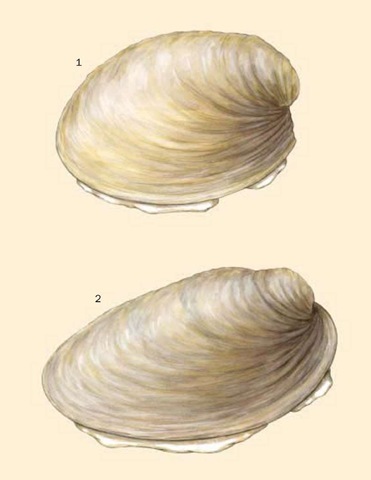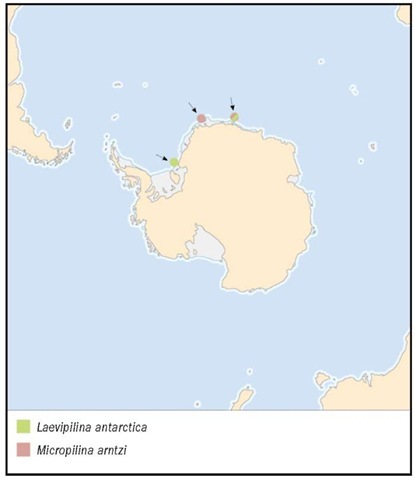Monoplacophora
(Monoplacophorans)
Phylum Mollusca
Number of families 1
Thumbnail description
Molluscans with a single symmetrical shell
Illustration: Laevipilina antarctica.

Evolution and systematics
Monoplacophorans are a small group of Cambro-Silurian fossils in the family Tryblidiidae. The single modern genus is Neopilina. In 1952, the Galathea expedition dredged 10 living specimens of Neopilina galathea from a deep trench of the Pacific Ocean. The specimens were found at a depth of 11,700 ft (3,570 m) in a bottom of dark, muddy clay off the west coast of Mexico. Later, four specimens of Neopilina ewingi were collected from the Peru-Chile Trench at a depth of slightly more than 9,840 ft (3,000 m). The monopla-cophorans had been classified with the chitons or the gastropods, and it was only on examination of the soft parts of living Neopilina specimens that it was recognized that a new class was needed for this genus and for the fossil genera Pilina, Scenella, Stenothecoides, Tryblidium, Archaeophiala, Drahomira, Proplina, and Bipulvina. All these fossil genera share a peculiar and distinctive feature: the undersurface of the shell has three to eight muscle scars that must be interpreted as homologous, segmentally repeated structures also present in the living genus Neopilina. This segmental internal structure is thought to show a relation between mollusks and annelids.
The survival of Neopilina species undoubtedly correlates with adaptation to life at great depths, and they are perhaps considerably more specialized than other members of the class. Fossil species appear to have evolved along two lines. In one group (subclass Cyclomya), there was an increase in the dorsoventral axis of the body, leading to a planospiral shell and a reduction of gills and retractor muscles. Although they disappeared from the fossil record in the Devonian, this group may have been ancestral to the gastropods. The other line (subclass Tergomya) retained a flattened shell with five to eight retractor muscles. Although this group also disappeared from the fossil record in the Devonian, it is believed to have survived in the genus Neopilina.
Monoplacophorans comprise one order (Tryblidioidea), one family (Neopilininae), four genera, and 17 recent species.
Physical characteristics
Monoplacophorans have a single symmetrical shell, which varies in shape from a flattened shieldlike plate to a short cone. The shell is large and bilaterally symmetric and has a single depressed, limpet-shaped valve. The apex of the shell lies almost vertically above the anterior margin in the median line. The margin of the shell is almost circular, being slightly elongated in the sagittal plane. The shell is relatively thin, has three layers, and is slightly thicker toward the margin than in the center.
A pallial groove (the mantle cavity) separates the edge of the foot from the mantle on each side. The mantle cavity forms a shallow gutter that entirely surrounds the animal. The cavity is delimited internally by the walls of the foot and laterally by the pallial fold that underlies the margin of the shell. Anteriorly, the mantle cavity contains the mouth, which is surrounded by the anterior velar ridge of a lateral fold and a pair of tentacle ridges. Laterally, the mantle cavity contains five or six pairs of gills, each of which is suspended from the roof of the mantle cavity by a slender base. The foot is a short circular column. The flat ventral wall of the foot is thin, transparent, relatively lacking in muscular support, and covered by ciliated epithelium, and it forms a creeping sole. A pedal gland, which lies along the anterior borders of the foot, may aid creeping movement by supplying mucus. Monopla-cophorans are 0.25 in (3 mm) to a little more than 1.25 in (3 cm) long and externally resemble a combination of gastropod and chiton. The head is small. The mouth is in front of the foot, and the anus is in the pallial groove at the posterior end of the body, behind the foot. In front of the mouth is a preoral fold, or velum, which extends on each side as a rather large ciliated palplike structure. Another fold lies behind the mouth and projects to each side as a mass of pos-toral tentacles.
Distribution
Deep seas (624-22,980 ft [190-7,000 m]) in various parts of the world, including the South Atlantic Ocean, Gulf of Aden, and a number of localities in the eastern Pacific Ocean
Habitat
Monoplacophorans live at great depths in the sea, crawling on radiolarians, attached to rocks, and in debris collected from the bottom.
Behavior
Nothing is known.
Feeding ecology and diet
Monoplacophorans feed on detritus.
Reproductive biology
The sexes are separate. There are no copulatory organs, no indication of sexual dimorphism, and no traces of sperm in the female reproductive system. It has been suggested that genital products (eggs and sperm) are discharged into the water column and that fertilization occurs externally.
Conservation status
No species are listed by the IUCN.
Significance to humans
Species in this taxonomic group are used for scientific research.

1. Micropilina arntzi; 2. Laevipilina antarctica.
Species accounts
No common name
Laevipilina antarctica
ORDER
Tryblidioidea
FAMILY
Neopilininae
TAXONOMY
Laevipilina antarctica Waren and Hain, 1992, Polarstern expedition ANT VII/4, station 245, 75°40.4′S, 029°37.2′W, 1,560 ft (480 m).
OTHER COMMON NAMES
None known.
PHYSICAL CHARACTERISTICS
The shell is small, fragile, depressed, and transparent with a flat peristome. The apex is slightly mamillate, forms an angle of approximately 60° with the basal plane, and is situated behind the anterior margin. The apical area has no distinct sculpture but has only regularly shaped impressions. Outside this area begins a uniform, concentric sculpture of low, raised ridges formed by the concentric arrangement of the prisms of the prismatic layer, which also form indistinct and fragmentary radial ridges. The shell is low. A convex curve forms gradually toward the posterior aspect, the highest point of the curve being somewhat behind the apex. The velar lobes are well developed and strongly ciliated. The anterior lip is conspicuous and rather thinly cuticularized. The postoral tentacles are short and

claviforme and equipped with approximately seven short, stumpy distal appendages. There are five pairs of gills. The foot (contracted) measures 0.06 by 0.04 in (1.5 by 0.9 mm). The gonads are visible as a large, lobate, dorsal sac along each side of the animal. The anus is a simple opening in the pallial furrow.
DISTRIBUTION
Weddell Sea, Lazarev Sea, Antarctica.
HABITAT
Stones or old shells in the sea at a depth of 690-2,100 ft (210-644 m).
FEEDING ECOLOGY AND DIET
All feed by scraping off the thin layer of sediment and eating mineral particles, unidentified organic material, scattered sponge spicules, radiolarian fragments, small nematodes, and polychaete bristles.
BEHAVIOR
Nothing is known.
REPRODUCTIVE BIOLOGY
Nothing is known.
CONSERVATION STATUS
Not listed by the IUCN.
SIGNIFICANCE TO HUMANS
Research use.
No common name
Micropilina arntzi
ORDER
Tryblidioidea
FAMILY
Neopilininae
TAXONOMY
Micropilina arntzi Waren and Hain, 1992, Polarstern expedition, station 173, 70°00.5′S, 03°16.8′W, 624-672 ft (191-204 m).
OTHER COMMON NAMES
None known.
PHYSICAL CHARACTERISTICS
The shell is very small, fragile, inflated, and almost semiglobu-lar and has a large, bulbous apex and flat peristome. The apex is mamillate and forms an angle of approximately 45° with the basal plane. Apart from occasional small pits, there is no distinct sculpture on the slightly worn apical area. Outside this area is a fine, irregularly concentric striation. In the furrows between the ridges are numerous small pits. The shell is unusually convex with the apex well in front of the anterior edge. The highest point of the shell is slightly anterior of center. No muscle scars can be discerned on the interior. The exterior layer of the shell does not contain defined prisms. The head is unusually large and bulging and has short, tapering, strongly ciliated velar lappets at the sides. The anterior lip seems to be very solid and cuticularized. Postoral tentacles are not present. The foot is round with a thickened rim. Three pairs of small, simple, tubercular gills are situated in the pallial groove and lack appendages. Five small, close-set muscle bundles are situated along the central third of the body halfway between the midline and the lateral margin.
DISTRIBUTION
Lazarev Sea, Antarctica
HABITAT
Sediment bottoms with stones and shells at 624-2,500 ft (191-765 m).
FEEDING ECOLOGY AND DIET
Nothing is known.
BEHAVIOR
Nothing is known.
REPRODUCTIVE BIOLOGY
Nothing is known.
CONSERVATION STATUS
Not listed by the IUCN.
SIGNIFICANCE TO HUMANS
Used in scientific research.
